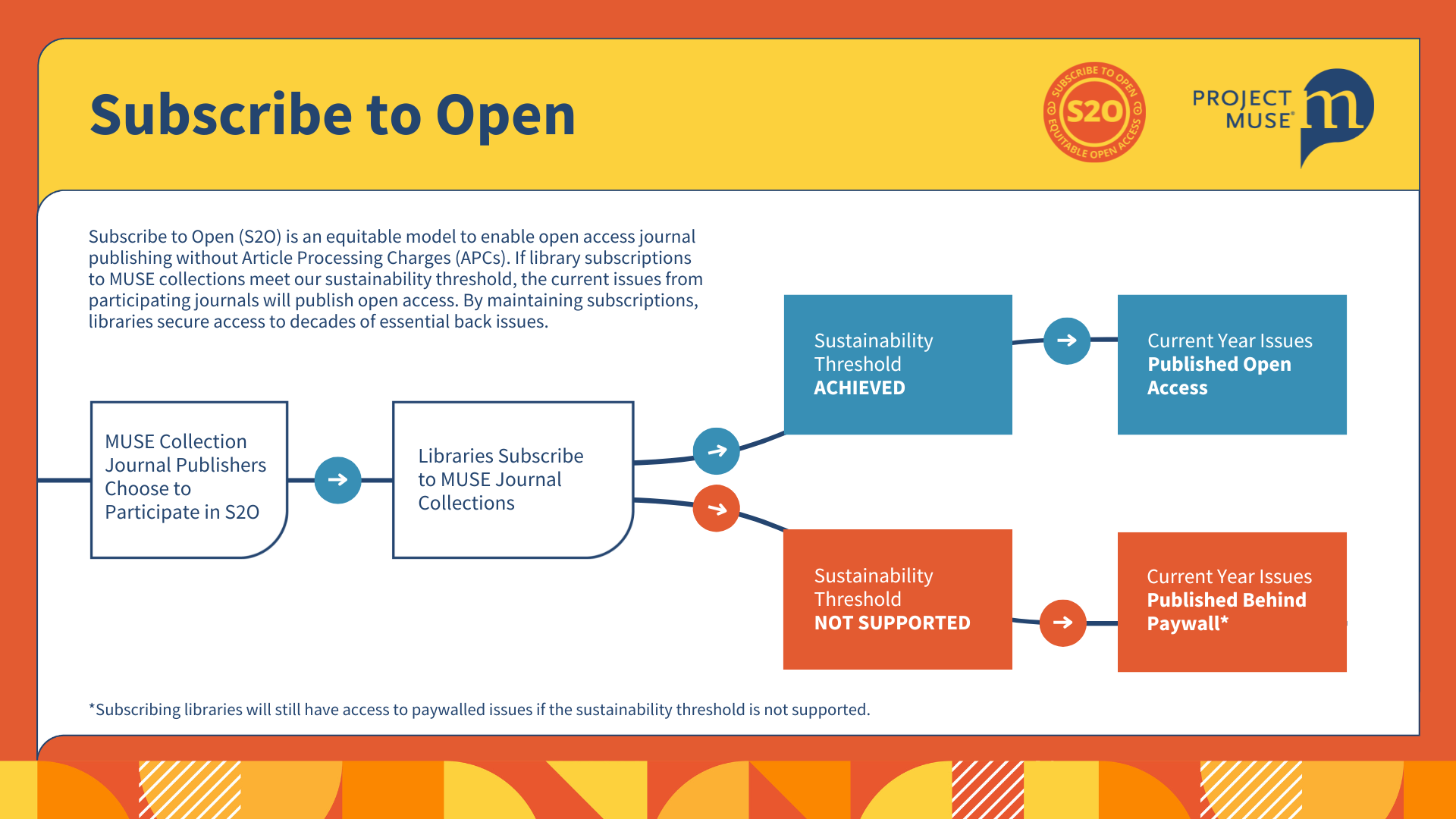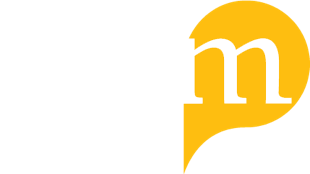Subscribe to Open for Project MUSE
Project MUSE > Subscribe to Open
What is Subscribe to Open?
Subscribe to Open (S2O) is an equitable open access model for scholarly journals that enables subscription journals to open access to their current content without Article Processing Charges (APCs). The Project MUSE S2O program is built around our current journal collections model and will launch with the calendar year 2025 subscription term for participating journals.
Why is Project MUSE pursuing a Subscribe to Open model?
With more than 700 current journals in the humanities and social sciences on its platform, from close to 200 nonprofit publishers, MUSE is uniquely positioned to develop and deploy an S2O offer at scale for a significant number of its journals. Through the support of MUSE’s vast community of publishers and libraries worldwide, the S2O model will open a wealth of vital scholarship in disciplines not well served by other open access (OA) models.
Supporters of MUSE understand the enormous value of humanities scholarship both in academic studies and in public spheres: shaping our understanding of the world and our place within it. Our community believes that humanities content from nonprofit publishers does not belong behind a paywall. This shift to open needs a unified approach to embark on a path to make this a reality.
What is the Subscribe to Open Model at Project MUSE?
The MUSE S2O program makes open access to the current year’s content of participating journals contingent on the continued support of MUSE subscribers. Each year, MUSE will set the minimum sustainability threshold required to fund the participating S2O journals that year. If the sustainability threshold is reached, the current year’s content of the participating titles will be opened to all readers. If the threshold is not reached, that year’s content will remain gated.
Additionally, subscribers will continue to enjoy access to MUSE’s deep backfile content. Nearly 200 journals have complete runs – from volume 1, issue 1 – available on the MUSE platform, and many journals in the MUSE collections have several decades of back volumes.

How does S2O impact subscriptions and access?
The MUSE S2O program builds upon the foundation of MUSE’s existing journal collections model that has been a valued platform for nonprofit university press and society publishers and a trusted resource in university libraries for nearly 30 years. The model provides a low-risk path to increasing access to a journal’s content that benefits both libraries and publishers in many ways:
- Makes high-quality humanities research from nonprofit publishers widely available to readers without barriers to access
- Ensures that subscribing libraries maintain uninterrupted access to both current scholarship and archival backfile content
- Costs no more than a library’s current conventional subscription
- Provides an alternative to article processing charges (APCs)
- Provides a stable and guaranteed royalty structure to support nonprofit journals and maintain the quality and integrity of their publications while making the transition to open
- Includes titles in all journal collections
Additionally, subscribers will conteinue to enjoy exclusive access to MUSE's deep backfile content. Nearly 200 journals have complete runs available on the MUSE platform (from volume 1, issue 1), and many journals in the MUSE collections have several decades of back volumes.
The success of the MUSE S2O program relies on the collective support and collaboration of various stakeholders, including researchers, institutions, libraries, funders, and publishers. By participating in the movement towards more open access and financially backing this important scholarship, we are all contributing to a more inclusive and equitable scholarly ecosystem.
Contact Us About S2OLearn More about Subscribe to Open
Journal Publishers Libraries & Institutions Sales Agents & Consortia List of Participating Journals
Get an even greater understanding of S2O by watching a Webinar "Connecting the Scholarly Community with an Equitable OA Model" (Recorded September 18th)
Frequently Asked Questions about S2O
S2O is a new and innovative model for expanding access to high-quality scholarly resources. As this approach is different from traditional subscription models, we understand you may have questions. Below, we've compiled answers to the most frequently asked questions to help you better understand and navigate S2O.
What is the Sustainability Threshold?
The S2O Sustainability Threshold represents the minimum subscription revenue required for the current year’s content to be opened.
MUSE will establish a revenue target each year that reflects the funding necessary to maintain the platform and its participating publishers. If subscription revenue reaches at least 98% of the revenue target – the “sustainability threshold” – by the S2O participation deadline, the current year’s content will be opened.
If the sustainability threshold is unsupported by the deadline, all content remains gated and available only to subscribers.
How are the annual revenue target and the sustainability threshold determined?
MUSE will set the S2O sustainability threshold to provide the minimum funding necessary to open the participating journals. The revenue target represents the net subscription revenue MUSE needs to maintain both Project MUSE’s operations, and those of our participating publishers, many of whom rely significantly on the royalties they receive from MUSE to sustain their publishing activities. Achieving the sustainability threshold will allow MUSE to distribute royalties to the journals in its collections and to support the ongoing operation of the MUSE platform.
What happens if subscription revenue does not achieve the S2O sustainability threshold in any given year?
Unless MUSE subscription commitments support the sustainability threshold by the participation deadline, the current year’s content from participating journals will remain behind paywall and only available to paid subscribers. Issues that participated in prior S2O years, or made open via alternative models, will remain open.
When will we know whether the S2O program has succeeded?
MUSE will communicate promptly and clearly regarding the success of the S2O program, immediately following the participation deadline (January of each year). If subscription commitments reach the sustainability threshold by the deadline, MUSE will publish that year’s current content from the participating titles as OA. Whether or not the open threshold is reached, subscribing institutions will continue to have access to both current and backfile content.
Does S2O provide equitable access?
S2O provides a more equitable solution than conventional subscriptions and APC models.
Unlike APC-based models, S2O allows authors—regardless of institutional affiliation—to publish an article without paying a fee or requesting a waiver. While institutions continue to pay subscription fees, those fees are distributed across institutions that have already demonstrated an ability and willingness to pay for access to the journal’s content. As multiple S2O programs open content, libraries gain access to content for which they do not pay a subscription fee, as well as to content to which they subscribe. In this way, S2O creates a network of reciprocity across libraries and delivers social benefits to libraries and the general public.
Is S2O a subscription payment or an Open Access payment?
Subscribe to Open is a subscription payment as current subscribers cannot ensure continued access without a payment. MUSE’s S2O program uses current library procurement processes to simplify communication and reduce administrative costs. Of course, this would not preclude a library from applying OA funds to some portion of their subscription renewal fee, if this was appropriate based upon local budgetary practices.
Still have questions?
We have additional information and resources available to help you navigate our S2O business model and your business needs. Please visit our dedicated resources for:
If you still can't find what you're looking for, get in touch with our team today.
Contact Us About S2OS2O Community of Practice
The S2O Community of Practice is a collective of publishers, libraries, consortia, and other stakeholders dedicated to collaborating, sharing knowledge, and advancing best practices to support and implement the S2O model for sustainable open access publishing.
Project MUSE is at the forefront of the Subscribe to Open (S2O) movement, pioneering sustainable open access models that ensure the broad dissemination of high-quality scholarly content. As a leading platform in the humanities and social sciences, we have embraced S2O to support equitable access to research and to promote a more inclusive and collaborative academic publishing landscape.
Our participation involves:
- Advocacy and education
- Collaborative development with industry leaders, partners, and stakeholders
- Pilot programs and case studies
- Policy and standards setting
- Community engagement
Through our leadership and active participation in the Subscribe to Open community of practice, Project MUSE is committed to advancing sustainable open access and ensuring that scholarly research remains accessible to all.
Learn more about the Subscribe to Open Community of Practice.




